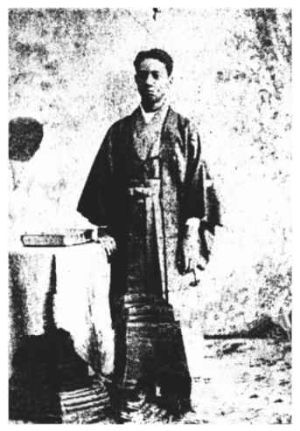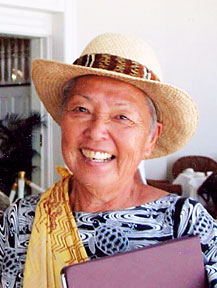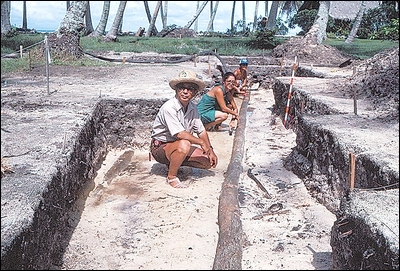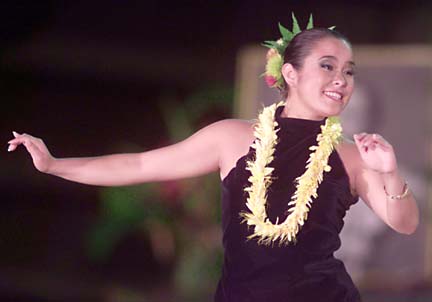Ku Holo La Komohana / Sail On to the Western Sun
Celebrating over 125 years of Historical Connections and Intercultural Exchanges between Hawai'i and Japan
During decades of interaction and exchange between Hawai'i and Japan, people of Japanese ancestry have become involved in Hawaiian langauge and culture, and people of Hawaiian ancestry involved in Japanese culture.
|
|
Isaac Harbottle (1871-1948)
In 1881, King David Kalakaua traveled from San Francisco to Yokohama and met with Emperor Meiji; the king was the first head of state to meet with the emperor after the opening on Japan in 1854.
Subsequent to this visit, King Kalakaua started Hawai‘i’s first study abroad program and sent young Hawaiian scholars to Japan (and China, Britain, Scotland, Italy, and America). The two students he sent to Japan were James Haku‘ole and Isaac Harbotttle, brothers, 11 and 10 years old, who grew up in Kipahulu, Maui. Isaac (1871-1948) was the great grandfather of Hokule‘a navigator Nainoa Thompson. The two boys arrived in Japan in 1882 to study the Japanese language and culture at Gakushuin University, also known as the Nobles School (Kuwazoku Gakko), with the aim of using their knowledge to aid in international affairs and the establishment of an immigrant worker program. Harbottle attended this school from 1883-1888.
In 1887, a group of haole businessmen took control of the government of Hawai‘i and presented Kalakaua with a new constitution restricting his powers. The students in the king’s study abroad program were summoned home the next year. From 1887-1888 Harbottle was classmate of Prince Yoshihito, who later became Emperor Taisho.
|
Patience Namakauahoaokawenaulaokalaniikiikikalaninui Wiggin Bacon
Born on Feb. 10, 1920, in Waimea, Kaua'i, of Japanese ancestry Bacon was orphaned at birth and brought to Honolulu, where she was adopted by Henry and Pa'ahana Wiggin; their daughter, Mary Kawena Pukui, a major 20th century scholar and teacher of Hawaiian language and culture, became Bacon's hanai mother. Bacon learned Hawaiian language, hula, chants, and other aspects of Hawaiian culture from her hanai mother and has spent a lifetime sharing this knowledge through educational programs while serving as a cultural resource specialist at Bishop Museum. The first part of Bacon's Hawaiian middle name means ‘haughty eyes of Kawenaulaokalani’; the second part was given by her grandmother to protect Bacon, connecting her with Pele. (From “The Auntie of Bishop Museum” by Zenaida Serrano, Honolulu Advertiser, August 17, 2005).
In 2004, Bacon was named a Living Treasures of Hawaii in a program sponsored by Honpa Hongwanji Mission of Hawaii to celebrate contributions to the islands' cultural heritage. In 2005, the Bishop Museum honored Bacon with the Robert J. Pfeiffer Medal for her dedication to the advancement of Hawai‘i’s cultural heritage, including the language and hula. Bacon was also the recipient of the first Mary Kawena Pukui Award given by the West Honolulu Rotary Club to honor a person not of Hawaiian ancestry who has made a significant contribution to the Hawaiian community through their chosen vocation or field of endeavor. (“Hall of Fame Member, Pat Bacon, Honored By W. Honolulu Rotary Club,” at the Hawaiian Music Hall of Fame and Museum website.)
|
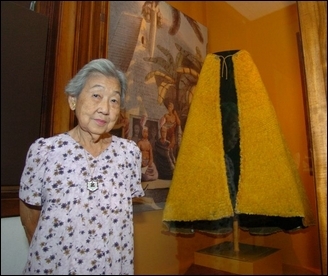
Photo by Deborah Booker, Honolulu Advertiser, August 17, 2005.
|
Native Hawaiians in Sumo: Jesse Kuhaulua, Chad Rowan, and George Kalima
In the 20th century, three native Hawaiian wrestlers entered and rose through the ranks of sumo, one of the most traditional of Japanese sport. The first was Jesse Kuhaulua, who wrestled as Takamiyama:
“Jesse Kuhaulua was born in Happy Valley, Maui, Hawaii in June 1944 to a Hawaiian father and a Japanese mother. In 1964, at the age of nineteen, Kuhaulua left Hawaii for Tokyo, and became the first American to enter the world of professional Japanese sumo. In March of 1964, Kuhaulua made his debut under the name of Takamiyama and began what would be a twenty year career. In 1968, Takamiyama was promoted to the Makuuchi division representing the highest level of Japanese sumo. Before his career was over, Takamiyama achieved the rank of sekiwake, the third highest in sumo, and established records for most consecutive tournaments (97) and most consecutive bouts (1425). The highlight of his career occurred in 1972, when he defeated Champion Asahikuni to win the Emperor’s cup and become the first foreign-born sumotori to win a championship. Upon his victory, a Japanese ambassador read a congratulatory message from President Richard Nixon, marking the first time that English words were spoken to a Japanese sumo audience.”(From the biography of Takamiyama at the American Sumo Association website; see also “Takamiyama one of sumo’s iron men,” by Ben Henry, Honolulu Star Bulletin, October 6, 1999); and "Jesse Kuhaulua" by Ferd Lewis Honolulu Advertiser, July 2, 2006).
Takamiyama’s success paved the way for other wrestlers from Hawai’i to enter sumo, including Saleva’a Atisanoe, of Samoan ancestry, who wrestled as Konishiki and who achieved the rank of Ozeki in 1987; native Hawaiian Chad Rowan, who wrestled as Akebono and who in January 1993, after a mere 30 matches, became the first foreigner to attain sumo’s highest rank of Yokozuna, the sixty-fourth grand champion in sumo history (see "Akebono" by Ferd Lewis Honolulu Advertiser, July 2, 2006); native Hawaiian George Kalima, who wrestled as Yamato and attained the rank of Maegashira in 1997; and Fiamalu Penitani, of Samoan-Tongan ancestry, who wrestled as Musashimaru and who became a sixty-seventh Yokozuna in 1999. “The Last Sumotori” by Ferd Lewis provides an overview of the achievements of sumo wrestlers from Hawai'i (Honolulu Advertiser, Saturday, October 2, 2004).
|
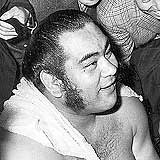
Sekiwake Takamiyama
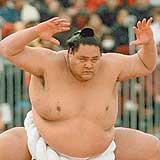
Yokozuna Akebono
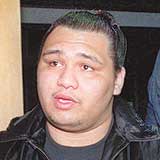
Maegashira Yamato
Photos from the American Sumo Association website.
|
Esther “Kiki” Takakura Mookini
In 2006, author, researcher, translator and teacher Esther “Kiki” Takakura Mookini received the Mary Kawena Pukui Award from the West Honolulu Rotary Club, given to honor a non-Hawaiian person who has made a significant contribution to the Hawaiian community through their chosen vocation or field of endeavor. (“Rotary to honor historian,” Honolulu Star-Bulletin, May 2, 2006).
Aunty Kiki was born in Pa’ia Maui, in 1924. Of Japanese ancestry, she married Edwin Mookini, who served as Chancellor of the University of Hawai‘i at Hilo (1975–1978). Kiki taught Hawaiian history and language at Kapi‘olani Community College and has translated several literary and historical texts from Hawaiian into English. In the 1990’s, her great love for Hawaiian culture led her to become involved with the voyaging canoe Hokule‘a as an educational consultant, crew member, and volunteer in the building of Hawai‘iloa.
In 2005, she was the first recipient of the Pa‘a Mo‘olelo Award from the Hawaiian Historical Society: “Mookini’s contributions to Hawaiian culture include service as a teacher and as a translator. In particular, her translations of historically significant works have made available bilingual texts for students and the general public. They include books such as Anatomia, 1838; various Hawaiian legends such as The Wind Gourd of La‘amaomao; and documents such as District Court Minutebooks. Her contributions to a variety of reference resources, including the Hawaiian Language Dictionary, Place Names of Hawaii, and The Hawaiian Newspapers have aided countless researchers and students.” (From “The Pa‘a Mo’olelo Award: Esther T. ‘Kiki’ Mookini Receives the First Award.”
|
Photo of Aunty "Kiki" from “Rotary to honor historian,” Honolulu Star-Bulletin, May 2, 2006.
|
Archaeologist Yosihiko H. Sinoto has contributed greatly to our knowledge of the Polynesian roots of Hawaiian culture. Born in Japan in 1925, the son of a plant geneticist, Sinoto developed an early interest in archaeology while collecting artifacts from a prehistoric village site near his school outside of Tokyo. Sinoto left Japan in 1954, planning to study American Indian paleolithic culture at the University of California-Berkeley. On the way, he took a detour to South Point on the Big Island where the Hawaiian and Pacific anthropologist Kenneth Emory was digging at an archaeological site. Emory recognized Sinoto’s training and skill in archaeology and persuaded him to stay on to help. Dr. Sinoto agreed to remain for a semester, which turned into a lifetime.
Dr. Sinoto is currently Senior Archeologist in the Hawaiian and Pacific Studies Department at the Bishop Museum. He is noted for his development of a fishhook chronology to date Polynesian archaeological sites. He has worked throughout Polynesia. His most remarkable discovery, on the grounds of the Bali Hai Hotel on the island of Huahine (see photo right), was the only remnants of an ancient voyaging canoe ever found—wooden planks and parts of a steering paddle and mast—buried in wet sand and preserved. The steering paddle suggests that the original one was about the same size and shape as the paddle developed in modern times to steer Hokule‘a. Sinoto has also worked on restorations of ancient sites, including a remarkable village of chiefs situated in an area called Maeva on Huahine.
Dr. Sinoto received the Robert J. Pfeiffer Medal from the Bishop Museum in 2006, for dedication to the advancement and perpetuation of Hawai'i's cultural heritage. He has also been honored with a Tahitian knighthood for his contributions to Tahitian archaelogy and resotration; and a membership in Japan's Order of the Rising Sun for his lifetime contributions to Polynesian prehistory.
|
Photo: Dr. Sinoto on Huahine, excavating the mast of an ancient voyaging canoe; from “Devoted to making discoveries,” by Mary Kaye Ritz, Honolulu Advertiser, Sunday, April 9, 2006.
Other online articles about Dr. Sinoto :
- “Marae Mysteries,” by Derek Ferrar, with photos, Hana hou! The magazine of Hawaiian Airlines, October/November 2003.
- “Colleagues Honor Sinoto,” Society For Hawaiian Archaeology, December 1999.
|
|
Photo by Carl Hefner, at Kauka de Silva.
|
Kauka de Silva, born in Hilo, Hawai'i, is a native Hawaiian ceramic artist and sculptor, who studied his art at Pratt Institute, University of Redlands, and Waseda University (Japan), as well as in Aizu Wakamatsu, Japan, under master mingei potter Takita, who was a student of Hamada Shoji and "classmate" of Shimaoka. Mingei pottery is "people’s art"; "mingei" refers to traditional craft objects made for daily use and enjoyment. Mingei involves years of training and intensive study. Local clays are used to make pottery that is intended for everyday use. Glazes are earthy and matte, colors are natural, such as indigo blue, rust red, forest green and chestnut brown. It is said that the simplicity of the design gives mingei pottery its true beauty. At the same time Kauka's clay works express his Hawaiian ancestry and the Hawaiian environment through their motifs, colors, and forms.
His work has been widely exhibited locally, nationally and internationally in places such as the Mingei-kan (Mingei Museum), the St. Louis Museum, the Stuttgart National Museum, the Honolulu Academy of Arts, Renwick Gallery, Parsons Gallery, and the Hawaii State Art Museum. His pots and sculptures are in numerous private and public collections such as The State Foundation on Culture and the Arts, the Mitsukoshi Collection, the Peabody Museum, the Honolulu Academy of Arts, and the Parsons Collection. Kauka’s studio “Huli Honua Pottery” is located in Hau’ula, Oahu.
A professor of art at Kapiolani Community College, Kauka is master teacher as well (Excellence in Teaching Award from the University of Hawai'i system, 2004). Since 1994, he has been passing on his art to student-apprentice Randall Ho.
|
|
|
Jennifer Kehaulani Oyama
Symbolic of the intercultural, multiethnic character of Hawai’i that emerged in the 20th century is Jennifer Kehaulani Oyama. In April 2003, 21 year old Jennifer Kehaulani Oyama, of half Japanese ancestry, mixed with Portuguese, Polish, Irish, Spanish and Hawaiian ancestries, won the Miss Aloha Hula title at the 40th Annual Merrie Monarch Festival in Hilo, considered the premiere hula competition in the world. She is a member of Halau Na Mamo O Pu`uanahulu, led by kumu hula Sonny Ching. She was also in a three-way tie for first place in the Hawaiian language competition after reciting 3 chants. Oyama began dancing hula at age 5 and joined Halau Na Mamo O Pu`uanahulu in 1994.
|
|

